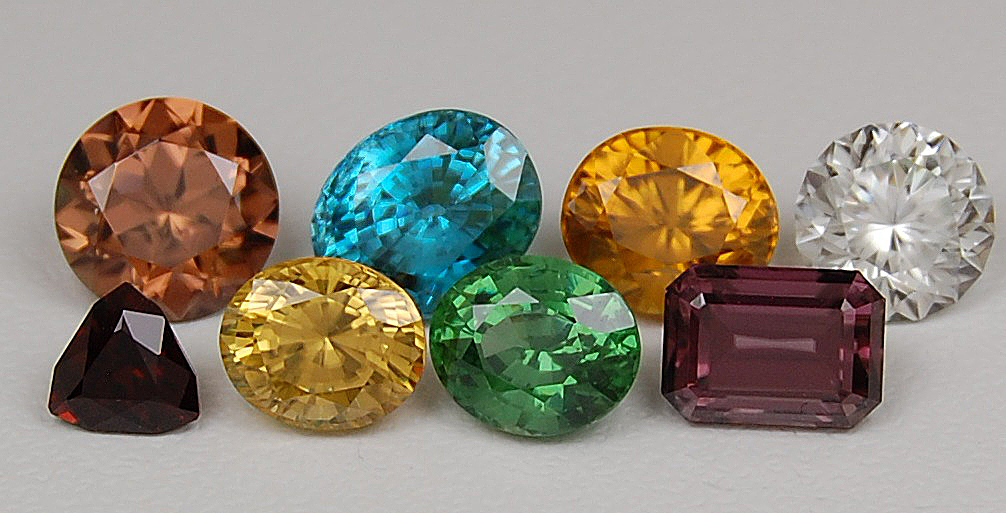
Introduction: Zircon is a mineral species often seen in the gem trade. Three types of zircon have been identified, high, low and intermediate. Where a zircon is classified is a function of it’s chemical structure. High zircons have a normal crystalline structure. Low zircons or metamict zircons have had their crystal structure changed by natural irradiation usually from uranium or thorium. In some cases, these zircons become almost amorphous and often have a cloudy look. The intermediate zircons are somewhere in between the high and low types where the crystalline structure has been partially affected. In practice, zircon is most often referred to simply as “zircon” with a color modifier, i.e. blue zircon, red zircon, yellow zircon, etc.
Colors: Blue, colorless, yellow, orange, brown, green, red, pink
Clarity: Blue and colorless zircons are Type I clarity. Gems of this type grow extremely clean in nature and usually have no eye visible inclusions. Orange, yellow, red and green are of Type II. Gems in this
type typically grow with some minor inclusions in nature that may be eye visible but usually are well hidden or require magnification. Blue and colorless zircons often contain tiny cottony inclusions. Low
type greens usually show strong zoning and twinning that may impart a foggy appearance. Skeletal and angular inclusions are also seen.
Stone Sizes: Most zircons in the gem market are less than 10 carats although stones up to 20 ct are not necessarily uncommon. Some zircons in museum collections are over 100 carats including a 208 ct gem at the American Museum of Natural History.
Localities: Zircon occurs in many countries but best known from:
-Cambodia: primary source of material capable of being heated to blue
-Tanzania: The discovery in recent years of brownish zircons from Songita and red zircon from Tonga have increased availability
-Burma (Myanmar): green and yellow zircons from Burma are found in the gem gravels with ruby and have a complex absorption spectra
-Thailand and Sri Lanka: important commercial sources of material over the years
Treatments:
-Heating (H) is done to improve and/or change color. Brown and red zircons can be heated under oxidizing conditions to change the color to a lighter red, orange, yellow or colorless. A second heating of
colorless zircons under reducing conditions can alter the stones to a blue color. To the best of my knowledge, the Cambodian rough yields most of the blue material. The Tanzanian sources are not able
to affect the change to blue from colorless. Green zircons are occasionally heated to lighten their tone. Heat treating of zircon is routinely done, usually stable and undetectable except the fact that colorless
and blue zircons do not occur in nature. Some heated orange stones revert back to brown within a short period of time (overnight) after heating. Others revert back to their original color after exposure to light.
Gemology:
-Refractive Index: 1.925-1.984 (+/-0.040) high type; 1.875-1.905 (+/-0.030) intermediate type;
1.810-1.815 (+/-0.030) low type
-Birefringence: 0.000 to 0.059 from low type to high type
-Optic Character: Doubly refractive, uniaxial positive (some of the low type is virtually singly refractive)
-Dispersion: 0.038 Interestingly, the dispersion is the same from the high type to the low type.
-Specific Gravity: 3.90 to 4.73 (increases from low type through high type)
-Hardness: 6 (low type) to 7.5 (high type)
-Toughness: heat treated stones are poor to fair and untreated stones are fair to good; Zircon is fairly
brittle. Edges and facet junctions are easily abraded.
-Chemical Composition: ZrSiO4 + Fe,U, Th, Hf
-Cause of Color: various color centers
-Absorption Spectra: Zircon spectra are very distinctive and useful in identification. The strongest
pervasive line is at 6535, seen even in types where a strong spectrum is absent. There are many lines
and bands across the whole spectrum from 40 lines in the Burmese green zircons to only a few lines in
Australian orange zircons.Heat treated stones and low types have a weak spectrum. Colorless, blue and
golden brown (all heat treated) stones show one line at 6535 and maybe one other line at 6590. Red
zircons may display no spectrum at all.
-Fluorescence: Red to orange-red stones are inert to strong yellow or orange in SW. Yellow to yelloworange
stones are inert to moderate yellow to orange (LW and SW). Greens are inert. Blues are inert to
moderate light blue (LW). Browns are inert to very weak red (SW).
-Cleavage: None
-Phenomena: Chatoyancy is not common but seen occasionally
Name: Zircon is from the Arabic zargun, zar (gold) and gun (color).
Dates: Zircon is the birthstone for December.
Care: Zircon can be safely cleaned with warm, soapy water. Ultrasonic and steam cleaners are risky.
To see available zircons by color, click on the zircon color..Blue..Brown..Green..White
To see all available zircons at the same time, type the word zircon into the search box and click go.
